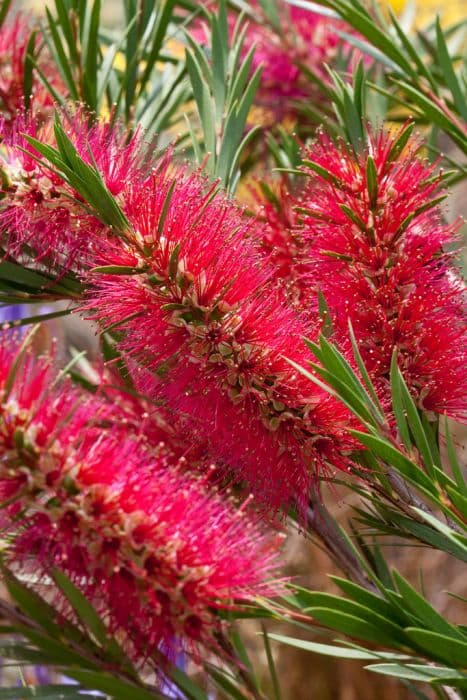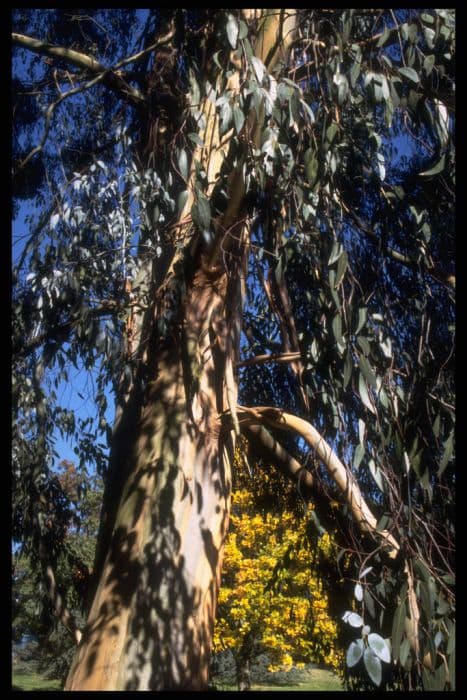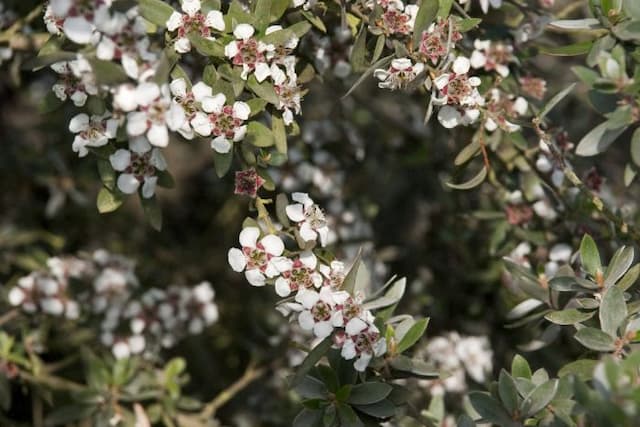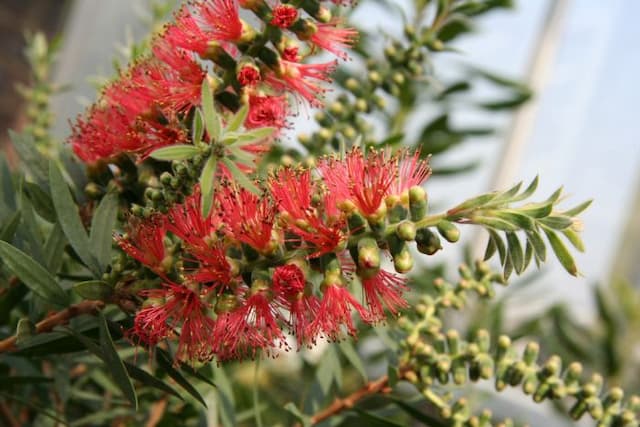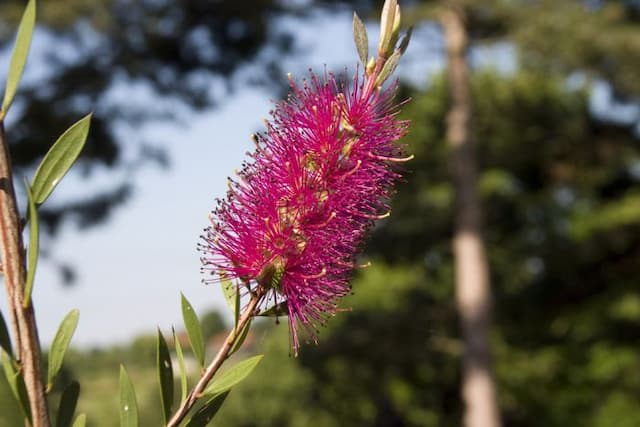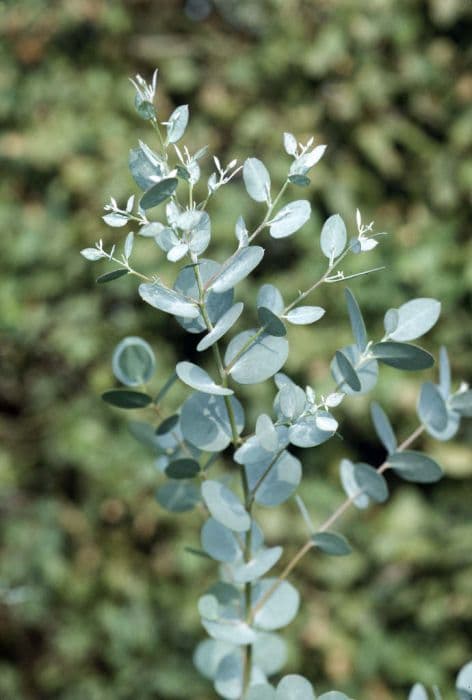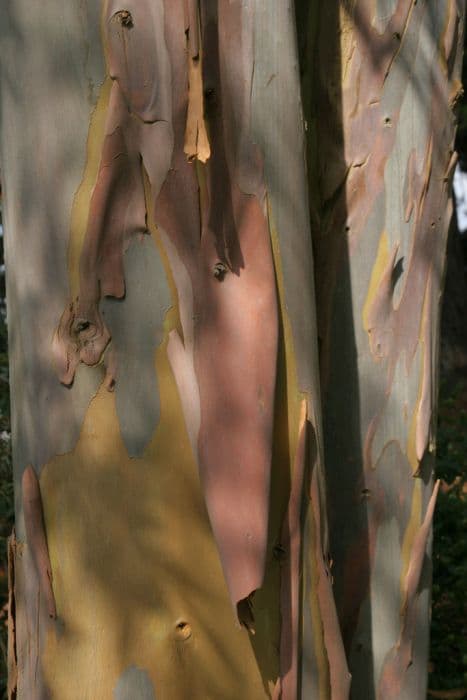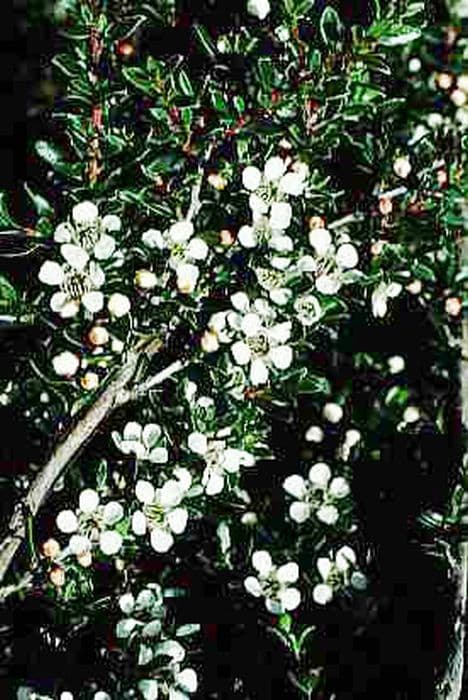Snow Gum Eucalyptus pauciflora

ABOUT
The Eucalyptus pauciflora, commonly known as the Snow Gum, is a visually striking plant with unique features that contribute to its aesthetic appeal. The Snow Gum is characterized by its smooth, mottled bark which peels away in ribbons to reveal a patchwork of white, gray, and green, giving it a distinctive appearance. During colder periods, the bark can take on a reddish tinge. This bark shedding is a natural process that occurs as the plant grows. Its leaves are a bright, glossy green and are known for their aromatic qualities when crushed. The leaf shape is elongate and curved, coming to a point at the end, which gives the foliage a somewhat narrow look. The leaves' arrangement on the branches can be dense, providing a lush canopy. The Snow Gum blossoms with white flowers that emerge from attractive, cream-colored, cup-shaped buds. These flowers tend to occur in clusters and can add a decorative element to the plant when in bloom. The fruit of the Snow Gum is a woody capsule that opens to release seeds, and it features a bell-like shape that persists even after the seeds have been dispersed. Overall, the Snow Gum has a sculptural quality with its patterned bark and elegant foliage against the backdrop of its unique flowers and fruits, creating a compelling aesthetic that can be appreciated in various settings where it is nurtured.
About this plant
 Names
NamesFamily
Myrtaceae.
Synonyms
Snow Gum, White Sally, Cabbage Gum, Weeping Gum, Ghost Gum.
Common names
Eucalyptus coriacea, Eucalyptus niphophila, Eucalyptus pauciflora subsp. niphophila, Eucalyptus pauciflora var. acerina, Eucalyptus pauciflora var. nana.
 Toxicity
ToxicityTo humans
The Snow Gum tree contains compounds that are toxic if ingested. Ingesting parts of the tree, such as leaves or oil, can lead to symptoms like nausea, vomiting, and diarrhea. In some cases, more severe symptoms such as abdominal pain, dizziness, or muscle weakness may occur. It is important to avoid ingesting any part of the Snow Gum tree and to seek medical attention if ingestion occurs.
To pets
The Snow Gum tree is also toxic to pets. If pets ingest parts of the tree, they can experience symptoms similar to those in humans, including vomiting, diarrhea, and depression. In severe cases, symptoms may progress to weakness, salivation, seizures, or even coma. Immediate veterinary care is crucial if a pet ingests any part of the Snow Gum tree.
 Characteristics
CharacteristicsLife cycle
Perennials
Foliage type
Evergreen
Color of leaves
Green
Flower color
White
Height
20-50 feet (6-15 meters)
Spread
15-20 feet (4.5-6 meters)
Plant type
Tree
Hardiness zones
7
Native area
Australia
Benefits
 General Benefits
General Benefits- Ornamental Value: Eucalyptus pauciflora, commonly known as the Snow Gum, is often used in landscaping for its aesthetic appeal due to its attractive bark and evergreen foliage.
- Wildlife Habitat: The Snow Gum provides habitat and food for a variety of wildlife, including birds and insects.
- Drought Resilience: Known for its drought tolerance, it is suitable for xeriscaping and can thrive in areas with low water availability.
- Soil Erosion Control: Its root system helps stabilize the soil, preventing erosion particularly in sloped areas.
- Windbreak: The Snow Gum can serve as a windbreak, protecting smaller plants and reducing wind speed in gardens and agricultural lands.
- Shade Provider: Its canopy offers shade that's beneficial during the hot summer months.
- Climatic Adaptability: It is capable of adapting to various climatic conditions, which makes it a versatile plant for different environments.
- Low Maintenance: Once established, Snow Gum trees require minimal maintenance, which is ideal for those seeking low-care garden options.
 Medical Properties
Medical Properties- Analgesic: Eucalyptus pauciflora leaves may contain compounds that have pain-relieving properties.
- Anti-inflammatory: The essential oil derived from the plant can have anti-inflammatory effects, which might help in reducing inflammation and swelling.
- Antimicrobial: Some studies suggest that the oil from Eucalyptus pauciflora has antimicrobial properties, potentially effective against certain bacteria, fungi, and viruses.
- Expectorant: Eucalyptus oil is traditionally used as an expectorant to help relieve coughs and assist in the removal of mucus from the respiratory tract.
- Decongestant: Inhalation of the vapors from eucalyptus oil can act as a decongestant, aiding in relief from nasal congestion.
 Air-purifying Qualities
Air-purifying QualitiesThis plant is not specifically known for air purifying qualities.
 Other Uses
Other Uses- Eucalyptus pauciflora, commonly known as Snow Gum, has leaves that can be used as a natural dye for fabrics, yielding a range of colors from gold to bronze depending on the mordant used.
- The wood of the Snow Gum is sometimes used in the crafting of musical instruments like didgeridoos for its tonal qualities and strength.
- In cold climates, Snow Gum has been used in windbreak plantings to provide protection for crops and smaller plants against strong winds.
- Due to its hardiness, Eucalyptus pauciflora is used in landscaping for erosion control, helping to stabilize soil on slopes and banks.
- Its burls and unique grain patterns make Snow Gum wood prized for making fine woodworking items, such as bowls, pens, and other artisanal objects.
- The tree's attractive, mottled bark has been used as a decorative element in garden and landscape design, providing visual interest throughout the year.
- Snow Gum can be planted as part of a fire-resistant landscaping strategy, since it is less flammable than many other eucalypt species.
- The timber of Eucalyptus pauciflora is sometimes used in light construction work, especially for interior paneling and trim where its ornamental value is appreciated.
- The leaves of Snow Gums have been utilized as a natural insect repellent, with its strong aromatic oils deterring a variety of pests.
- In areas with heavy snowfall, Eucalyptus pauciflora can be used as an indicator species for the extent of snow coverage due to its distinct, snow-resistant canopy.
Interesting Facts
 Feng Shui
Feng ShuiSnow Gum is not used in Feng Shui practice.
 Zodiac Sign Compitability
Zodiac Sign CompitabilitySnow Gum is not used in astrology practice.
 Plant Symbolism
Plant Symbolism- Resilience: Eucalyptus pauciflora, commonly known as Snow Gum, often grows in cold and high altitude environments, symbolizing the ability to withstand harsh conditions and adapt to challenging environments.
- Healing: The eucalyptus plant has medicinal properties, particularly in its oil, which is used for its antiseptic and healing qualities, thus symbolizing health and recovery.
- Cleansing: Eucalyptus is believed to have purifying effects, both in terms of its clean scent which is thought to clear the air as well as spiritually, symbolizing the removal of negative energy.
- Protection: With its strong and enduring nature, the Snow Gum is often associated with safeguarding and is thought to offer protection to its surroundings.
- Renewal: The plant's ability to regenerate quickly after being damaged symbolizes renewal and the idea of making a fresh start or turning over a new leaf.
 Water
WaterThe Snow Gum should be watered deeply but infrequently, promoting strong root growth. Generally, watering once every two weeks during active growing seasons in spring and summer is sufficient, but always check the soil moisture; it should be dry a couple of inches down before you water again. During winter, reduce watering to once a month, as the plant prefers drier conditions when dormant. Amounts can vary based on size and weather conditions, but a young tree might need 5 gallons per watering, while mature trees can require 10 to 15 gallons to ensure the root zone is moistened.
 Light
LightSnow Gums prefer full sun to partial shade, thriving best with direct sunlight for at least six hours a day. They should be planted in a spot where they can receive unfiltered sunlight throughout the majority of the day. Avoid deep shade as it can hinder growth and lead to sparse foliage.
 Temperature
TemperatureThe Snow Gum is remarkably cold-hardy, tolerating temperatures down to -20 degrees Fahrenheit, but optimal growth occurs between 60 and 75 degrees Fahrenheit. They can survive summer highs up to 100 degrees Fahrenheit. It's the extreme cold tolerance that distinguishes this Eucalypt from others, enabling it to thrive in USDA zones 7 to 8 without concern for winter freezes.
 Pruning
PruningPrune Snow Gums to remove dead or damaged branches and to shape the tree or manage its size. Pruning should be done in late winter or early spring before new growth begins. Mature trees require minimal pruning and often only to remove limbs that could pose a hazard. Light pruning every few years is typically sufficient to maintain their aesthetic and health.
 Cleaning
CleaningAs needed
 Soil
SoilThe Snow Gum prefers well-draining sandy loam soil with a pH range between 6.0 and 7.5. The best soil mix can be created by combining two parts sandy loam, one part peat and one part perlite or coarse sand to ensure good aeration and drainage, which are vital for the health of this eucalypt species.
 Repotting
RepottingSnow Gums, being fast-growing trees, should be repotted every two to three years to prevent becoming root-bound and to replenish nutrients. Larger specimens can be top-dressed instead of repotted to minimize root disturbance.
 Humidity & Misting
Humidity & MistingSnow Gums are tolerant of a wide range of humidity levels. They thrive in moderate to low humidity typical of the temperate climates they originate from, and do not require any special humidity adjustments when grown outdoors in their preferred environments.
 Suitable locations
Suitable locationsIndoor
Place in bright, indirect light and ensure good air circulation.
Outdoor
Plant in full sun, shelter from strong winds.
Hardiness zone
7-11 USDA
 Life cycle
Life cycleEucalyptus pauciflora, commonly known as Snow Gum, starts its life cycle when a seed, often dispersed by the wind, finds suitable soil to germinate, usually requiring exposure to sunlight and a mild to cold stratification period. The germinated seedling develops a root system and shoots that grow into a young sapling, adapting to withstand cold and frost-prone environments, characteristic of its alpine habitat. As the sapling matures, it undergoes a period of rapid growth and eventually becomes a mature tree, distinguished by its smooth, white to light grey bark and lance-shaped leaves. The Snow Gum reaches reproductive maturity, producing flowers with fluffy stamens which, upon pollination by insects such as bees, form woody fruit capsules containing numerous seeds. These capsules may open and release their seeds in response to environmental triggers such as fire or during their annual cycle in the warmer months. Completing its life cycle, the mature Snow Gum may live for several decades, continuously reproducing and contributing to its population's maintenance, with the ability to resprout from lignotubers after bushfires, ensuring resilience and longevity of the species.
 Propogation
PropogationPropogation time
Spring-Early Summer
The Eucalyptus pauciflora, commonly known as snow gum, is typically propagated through seed germination. The most popular method of propagation for this plant involves collecting the ripe fruits in late summer when they begin to split open and scatter seeds. These seeds should be sown in a well-drained seeding mix, lightly covered with soil, and kept moist until germination occurs. Optimal germination temperature ranges between 50 to 55 degrees Fahrenheit (10 to 13 degrees Celsius), and seeds usually germinate within two to four weeks. Seedlings can then be gradually hardened off and transplanted outdoors in the spring when the risk of frost has passed and they've grown strong enough to survive the elements.

